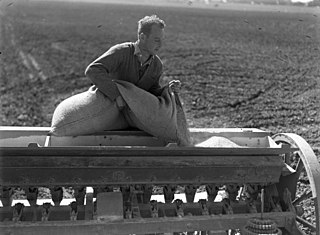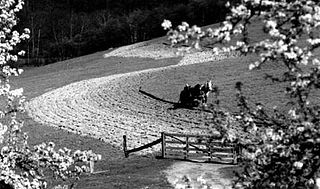
A plough or plow is a farm tool for loosening or turning the soil before sowing seed or planting. Ploughs were traditionally drawn by oxen and horses but in modern farms are drawn by tractors. A plough may have a wooden, iron or steel frame with a blade attached to cut and loosen the soil. It has been fundamental to farming for most of history. The earliest ploughs had no wheels; such a plough was known to the Romans as an aratrum. Celtic peoples first came to use wheeled ploughs in the Roman era.

Tillage is the agricultural preparation of soil by mechanical agitation of various types, such as digging, stirring, and overturning. Examples of human-powered tilling methods using hand tools include shoveling, picking, mattock work, hoeing, and raking. Examples of draft-animal-powered or mechanized work include ploughing, rototilling, rolling with cultipackers or other rollers, harrowing, and cultivating with cultivator shanks (teeth).

In agriculture, a harrow is a farm implement used for surface tillage. It is used after ploughing for breaking up and smoothing out the surface of the soil. The purpose of harrowing is to break up clods and to provide a soil structure, called tilth, that is suitable for planting seeds. Coarser harrowing may also be used to remove weeds and to cover seed after sowing.

A seedbed or seedling bed is the local soil environment in which seeds are planted. Often it comprises not only the soil but also a specially prepared cold frame, hotbed or raised bed used to grow the seedlings in a controlled environment into larger young plants before transplanting them into a garden or field. A seedling bed is used to increase the number of seeds that germinate.
The stale seed bed or false seed bed method is a weed control technique used at both the farm and garden scales. In this that the young weeds can then be easily eliminated. By destroying them early, the farmer or gardener eliminates most of that season's annual weeds, which reduces their labor and improves their crop yields.

Weed control is a type of pest control, which attempts to stop or reduce growth of weeds, especially noxious weeds, with the aim of reducing their competition with desired flora and fauna including domesticated plants and livestock, and in natural settings preventing non native species competing with native species.

No-till farming is an agricultural technique for growing crops or pasture without disturbing the soil through tillage. No-till farming decreases the amount of soil erosion tillage causes in certain soils, especially in sandy and dry soils on sloping terrain. Other possible benefits include an increase in the amount of water that infiltrates into the soil, soil retention of organic matter, and nutrient cycling. These methods may increase the amount and variety of life in and on the soil. While conventional no-tillage systems use herbicides to control weeds, organic systems use a combination of strategies, such as planting cover crops as mulch to suppress weeds.

A seed drill is a device used in agriculture that sows seeds for crops by positioning them in the soil and burying them to a specific depth while being dragged by a tractor. This ensures that seeds will be distributed evenly.

Agricultural wastewater treatment is a farm management agenda for controlling pollution from confined animal operations and from surface runoff that may be contaminated by chemicals in fertilizer, pesticides, animal slurry, crop residues or irrigation water. Agricultural wastewater treatment is required for continuous confined animal operations like milk and egg production. It may be performed in plants using mechanized treatment units similar to those used for industrial wastewater. Where land is available for ponds, settling basins and facultative lagoons may have lower operational costs for seasonal use conditions from breeding or harvest cycles. Animal slurries are usually treated by containment in anaerobic lagoons before disposal by spray or trickle application to grassland. Constructed wetlands are sometimes used to facilitate treatment of animal wastes.

Contour bunding or contour farming or Contour ploughing is the farming practice of plowing and/or planting across a slope following its elevation contour lines. These contour lines create a water break which reduces the formation of rills and gullies during times of heavy precipitation, allowing more time for the water to settle into the soil. In contour plowing, the ruts made by the plow run perpendicular rather than parallel to the slopes, generally furrows that curve around the land and are level. This method is also known for preventing tillage erosion. Tillage erosion is the soil movement and erosion by tilling a given plot of land. A similar practice is contour bunding where stones are placed around the contours of slopes. Contour ploughing has been proved to reduce fertilizer loss, power and time consumption, and wear on machines, as well as to increase crop yields and reduces soil erosion.

Soil conservation is the prevention of loss of the topmost layer of the soil from erosion or prevention of reduced fertility caused by over usage, acidification, salinization or other chemical soil contamination.

A cultivator is a piece of agricultural equipment used for secondary tillage. One sense of the name refers to frames with teeth that pierce the soil as they are dragged through it linearly. It also refers to machines that use the rotary motion of disks or teeth to accomplish a similar result. The rotary tiller is a principal example.

A road roller is a compactor-type engineering vehicle used to compact soil, gravel, concrete, or asphalt in the construction of roads and foundations. Similar rollers are used also at landfills or in agriculture.

Nonpoint source (NPS) pollution refers to diffuse contamination of water or air that does not originate from a single discrete source. This type of pollution is often the cumulative effect of small amounts of contaminants gathered from a large area. It is in contrast to point source pollution which results from a single source. Nonpoint source pollution generally results from land runoff, precipitation, atmospheric deposition, drainage, seepage, or hydrological modification where tracing pollution back to a single source is difficult. Nonpoint source water pollution affects a water body from sources such as polluted runoff from agricultural areas draining into a river, or wind-borne debris blowing out to sea. Nonpoint source air pollution affects air quality, from sources such as smokestacks or car tailpipes. Although these pollutants have originated from a point source, the long-range transport ability and multiple sources of the pollutant make it a nonpoint source of pollution; if the discharges were to occur to a body of water or into the atmosphere at a single location, the pollution would be single-point.

In geotechnical engineering, soil compaction is the process in which stress applied to a soil causes densification as air is displaced from the pores between the soil grains. When stress is applied that causes densification due to water being displaced from between the soil grains, then consolidation, not compaction, has occurred. Normally, compaction is the result of heavy machinery compressing the soil, but it can also occur due to the passage of, for example, animal feet.

A rolling pin is a cylindrical food preparation utensil used to shape and flatten dough. Two styles of rolling pin are found: rollers and rods. Roller types consists of a thick cylinder with small handles at each end; rod type rolling pins are usually thin tapered batons. Rolling pins of different styles and materials offer varying advantages, as they are used for different tasks in cooking and baking.
During the Sangam age, 800 BCE – 300 CE, agriculture was the main vocation of the Tamil. It was considered a necessity for life, and hence was treated as the foremost among all occupations. The farmers or the Ulavar were placed right at the top of the social classification. As they were the producers of food grains, they lived with self-respect. Agriculture during the early stages of Sangam period was primitive, but it progressively got more efficient with improvements in irrigation, ploughing, manuring, storage and distribution. The ancient Tamils were aware of the different varieties of soil, the kinds of crops that can be grown on them and the various irrigation schemes suitable for a given region. These were also in Madras, Thanjore.

Ransome Victory Plough is a type of single-share mouldboard plough commonly used throughout Southern Africa. Introduced into much of Southern Africa in the mid-1920s via European farmers and missionaries, it was quickly adopted over earlier, heavier models that required multiple spans (teams) of oxen. The Ransome Victory's relatively light weight allowed it to be pulled by a single span of oxen, allowing more smallholder farmers who owned fewer cattle to utilize the technology.

The land imprinter is a no-till device for establishing grass cover in arid environments and deserts. The imprinter consists of a metal roller, with steel angles welded to the surface in various configurations. The angled teeth of the imprinter cut through weeds and brush to form a mulch, while the teeth press seeds of grasses and other plants into the soil. The imprints remain stable for approximately two years. During that time, imprints funnel water toward seedlings, protect them from wind, and concentrate nutrients for plant growth.
This glossary of agriculture is a list of definitions of terms and concepts used in agriculture, its sub-disciplines, and related fields, including horticulture, animal husbandry, agribusiness, and agricultural policy. For other glossaries relevant to agricultural science, see Glossary of biology, Glossary of ecology, Glossary of environmental science, and Glossary of botanical terms.





















